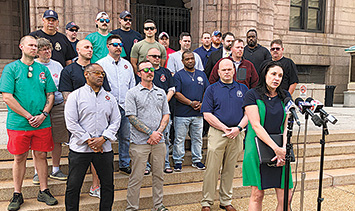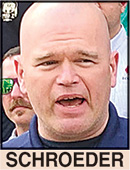By TIM ROWDEN
Managing Editor

The unions representing St. Louis City police and fire department employees are calling for the city to act on the findings of a city-funded compensation study that recommended raising pay for their members.
Members of the St. Louis Police Officers Association (SLPOA) and International Association of Firefighters Local 73 (IAFF 73) gathered on the steps of City Hall March 21 to discuss the results of the recently released report, which showed police and fire fighters in the city are paid significantly less that those in cities of similar size and population.
The city commissioned the study two years ago. It was completed May of 2021, but only recently was released after the unions filed a Freedom of Information Act (FOIA) request, also known as a Sunshine request.
“Our public safety employees, our fire fighters, our EMTs, our paramedics, our dispatchers and the police department employees are even more underpaid than we thought,” said Emily Perez, the attorney for IAFF Local 73 who filed the Sunshine request.
The more than 300-page report compiled by the city’s third-party consultant Management Advisory Group International, Inc., or MAG, evaluated the pay and structure for more than 600 city positions last year, comparing St. Louis to similarly sized cities such as Cincinnati, Detroit, Indianapolis and Louisville, as well as Kansas City, Memphis and the neighboring governments of St. Louis County and St. Charles County.
Comparing salaries and various other factors, the report recommends a citywide annual payroll increase of 7.6 percent.
BELOW NEIGHBORING AND SIMILAR COMMUNITIES
For police and fire fighters, the study showed the average police officer and fire department private makes about $47,800 a year. Based on comparisons with similar communities, the report recommends the city raise the pay range to $54,800 through $75,600, an increase of about 14.5 percent.
The study also recommended raising the pay for fire, EMS and police dispatchers. If recommendations are followed, the top of the salary range for police dispatchers would increase more than 25 percent from $51,000 to $65,000.
MAG recommended that the new pay structure and salaries go into effect “as soon as feasible.”
That was nearly a year ago.
The city has struggled to hire and retain public safety and other employees in recent years.
Of 5,609 overall employment positions in the city, more than 600 are vacant, creating a situation where those who remain are both overworked and underpaid.
 IMPACT ON PUBLIC SAFETY
IMPACT ON PUBLIC SAFETY
IAFF 73 President Demetris “Al” Alfred said the city’s refusal to implement the raises has an impact on public safety, particularly as EMS has struggled to staff ambulances and its 911 center.
“If you pay people, they will stay,” Alfred said.
 St. Louis Police Officers Association President Jay Schroeder said the pay for city police officers has been falling behind for years. “And it’s starting to show in our recruiting,” he said. “It’s just getting harder and harder to have a living wage here. These guys work nonstop, undermanned. I think it’s time that the city, time that City Hall shows that they support their police.”
St. Louis Police Officers Association President Jay Schroeder said the pay for city police officers has been falling behind for years. “And it’s starting to show in our recruiting,” he said. “It’s just getting harder and harder to have a living wage here. These guys work nonstop, undermanned. I think it’s time that the city, time that City Hall shows that they support their police.”
Fire Fighter Dan Clark said those who stay with the city do so because they love their work and serving the city, but it comes at a price.
 “We love what we do. We love representing the city. We love working for the city,” Clark said. “A lot of us work second jobs to make ends meet.”
“We love what we do. We love representing the city. We love working for the city,” Clark said. “A lot of us work second jobs to make ends meet.”
The St. Louis Post-Dispatch reported last fall that officer departures were up 60 percent through September 2021, while new hires had fallen by 25 percent.
NOW IS THE TIME
Perez noted that the unions’ call for higher pay comes as St. Louis has seen an influx of funds including $135 million in federal pandemic aid and the city’s share of a $790 million settlement over the NFL’s Rams exodus from St. Louis to Los Angeles.
“Why this should not be the time to invest in our city employees is a question that answers itself,” Perez said.


